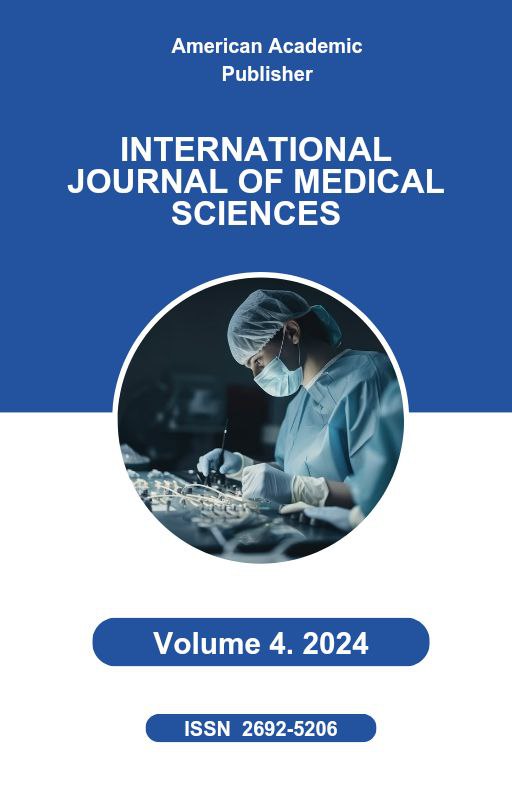 Articles
| Open Access |
https://doi.org/10.55640/
Articles
| Open Access |
https://doi.org/10.55640/
TRANSCRANIAL MAGNETIC STIMULATION (TMS) - A METHOD USED TO TREAT EARLY AUTISM IN THE ARAL SEA REGION
Niyazimbetova Umida Yusupbaevna , Psychiatrist Branch of the Republican Specialized Scientific and Practical Medical Center for Mental Health for Psychiatric Service of the Republic of KarakalpakstanAbstract
The article presents a review and analytical study of the use of transcranial magnetic stimulation (TMS) as an additional method of treating autism spectrum disorders (ASD) in children, using the example of practice in the Republic of Karakalpakstan. The author, psychiatrist Umida Yusupbaevna Niyazimbetova, focuses on the relevance of the problem of early childhood autism, the difficulties of diagnosis and the limitations of traditional methods of therapy. TMS is considered as a promising, non-invasive neuromodulation technology capable of correcting key symptoms of ASD: decreased social adaptation, autostimulation, anxiety, and deficits in verbal and non-verbal communication. Based on data from international and domestic studies, including clinical observations at the Nukus Psychoneurological Dispensary, the potential effectiveness of TMS has been substantiated, especially when using repetitive (rTMS) and theta-rhythmic stimulation (iTBS). The proposed neurophysiological mechanisms of action of TMS are considered: restoration of the balance of excitation and inhibition in the brain, stimulation of the prefrontal cortex, improvement of neuroplasticity and emotional regulation. The need for an integrated approach combining TMS with behavioral therapy and cognitive rehabilitation is emphasized.
Despite the encouraging results, the author notes the limited evidence base, small samples and the need for further randomized controlled trials. Nevertheless, TMS is considered a promising direction in neuropsychiatry, opening up new opportunities for improving the quality of life of children with ASD.
Keywords
autism, early childhood autism, autism spectrum disorders (ASD), transcranial magnetic stimulation (TMS), neuromodulation, rTMS, iTBS, neuroplasticity, social adaptation, behavioral therapy, child psychiatry, innovative treatment methods.
References
Lebedinskaya K.S., Nikolskaya O.S. Diagnostics of early childhood autism: Initial manifestations. - M.: Education, 1991. P.2.
Effects of transcranial magnetic stimulation in autism (ASD) // https://neurolab.kz/news/effekty-transkranialnoj-magnitnoj-stimulyacii-pri-autizme-ras--328.html
Kirkovski et al. Atypical alpha band microstates produced during eyes-closed resting state EEG in autism. Prog Neuropsychopharmacol Biol Psychiatry. 2024 Apr 20;131:110958. doi: 10.1016/j.pnpbp.2024.110958. Epub 2024 Feb 1.PMID: 38309329
Lindsay M Oberman, Peter G Enticott, Manuel F Casanova, Alexander Rotenberg, Alvaro Pascual-Leone, James T McCracken. TMS in ASD Consensus Group. Transcranial magnetic stimulation in autism spectrum disorder: Challenges, promise, and roadmap for future research, 2016. PMID: 26536383; PMCID:PMC4956084;DOI:10.1002/aur.1567
Transcranial magnetic stimulation in the management of autism spectrum disorder: Narrative review M. Adnan, M. Zafar, C. Trivedi and U. Beg. Corresponding author. doi: 10.1192/j.eurpsy.2021.1313 // cambridge.org
Repetitive transcranial magnetic stimulation modulates long-range functional connectivity in autism spectrum disorder – ScienceDirect // https://www.sciencedirect.com
Kang et al., 2019 – “Effects of repetitive transcranial magnetic stimulation on children with lowfunction autism” // https://www.onlinelibrary.wiley.com
Smith et al., 2022 – “Treatment Response of Transcranial Magnetic Stimulation in Intellectually Capable Youth and Young Adults with ASD: A Systematic Review and MetaAnalysis” // https://www.pmc.ncbi.nlm.nih.gov
Article Statistics
Downloads
Copyright License

This work is licensed under a Creative Commons Attribution 4.0 International License.

